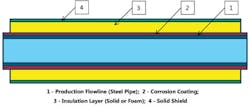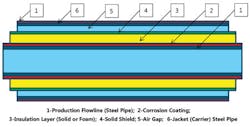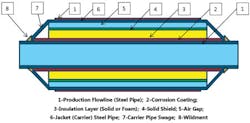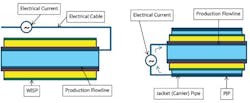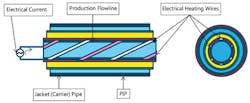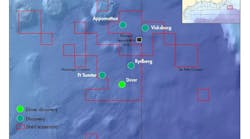Jianlin Cai
INTECSEA
Flow assurance is one of the most critical operational issues for subsea production systems. Large amounts of capex and/or opex need to be invested in the subsea systems to prevent such issues from happening during normal production operations and transient periods. Among all of the various types of flow assurance issues that operators may encounter, some can be mitigated by non-chemical solutions while the others have to be mitigated by production chemicals.
The “2016 survey of Offshore Non-Chemical Flow Assurance Solutions Poster,” contained within this issue, provides an overview for the current state-of-art non-chemical solutions for flow assurance issues.
Since flow assurance deals with almost all the aspects of subsea production systems, this poster is limited to the hardware part of the non-chemical solutions for the subsea systems. The survey, which was the basis of the poster, focused on the thermal insulation systems and products available in the industry. Eighteen companies responded the survey and their products are listed on the poster. Most of these companies provide passive insulation systems, wet or dry, and a few companies provide active heating and other products.
Flow assurance issues
Generally, the following flow assurance issues are the biggest concerns for deepwater subsea production systems:
- Hydrate
- Wax
- Scale
- Asphaltene
- Corrosion and Erosion
- Emulsion
- Sand
- Slugging.
The flow assurance issues are related to the reservoir fluid compositions and properties, system pressure and temperature conditions, water content (water cut), and system configurations. Of all the issues above, hydrate, wax, scale, and corrosion are the most critical issues for subsea multi-phase production systems, both oil and gas. Some of the issues, such as hydrate and wax, can be mitigated and remediated by non-chemical measures, i.e. thermal management of the system.
Hydrate blockage is the most critical issue for most subsea production systems. Hydrate blockage in these systems can halt production, and is difficult to remediate. Generally, the conditions for hydrate formation are free water, light gases, i.e. methane, and H2S, low temperature and high pressure. Among these conditions, water content and gases are determined by reservoir conditions and cannot be controlled by the operator. Only the temperature and pressure can be managed by the system design and operational procedures.
The mitigation methods usually include thermal insulation of the system, inhibitor injection, pressure management, and preventive intervention. Thermal insulation of the system to keep production fluid temperature high is the simplest and most efficient way to prevent hydrate formation.
Wax precipitation and deposition is another critical issue for subsea oil and gas production. Wax content and wax appearance temperature (WAT) are the fluid indicators of the tendency of wax deposition. Wax precipitation and deposition mostly depend on the production fluid temperature; and low temperature, in turn, will increase the risk of these two conditions. Thus, the primary mitigation strategy is maintaining the fluid temperature above WAT in the system. Mechanical removal by pigging operations and hot oil circulation to remove wax deposition are other non-chemical solutions.
Asphaltene flocculent heavily depends on the reservoir fluid characteristics and involvement of light gases. Pressure and temperature will determine asphaltene onset conditions. However, historically, chemical inhibition and mechanical removal by pigging are the preferred mitigation measures if asphaltene becomes an issue for the subsea production system.
Corrosion issues are related to corrosive components in the reservoir fluids and produced water, as well as the operating conditions (pressure and temperature). Controlling the operating conditions has little impact on the corrosion prevention. Generally, corrosion-resistant alloy (CRA) material selection and chemical inhibitor are the primary mitigation strategies.
The primary mitigation strategy for excessive erosion can be based on controlling the production fluid speed in the system; i.e., the API 14E limits and use of CRA materials. Emulsion occurs when oil and water are mixed together. A stable emulsion can increase production fluid viscosity substantially. A typical solution is to use chemical to prevent its formation or break the emulsion after it is formed in the system.
Sand deposits in the system are another risk for subsea production systems. A typical mitigation strategy is to manage the sand content in the fluids via downhole sand control devices, and keeping the production above the minimum sand setting production rate. However, sand and high production rates will increase the erosion. Pigging and dynamic flushing can be used to remove sand accumulation in the system.
Slug flow is an operational challenge and severe slugging may cause production shutdown. Slug flow can be managed by proper production condition control, such as flowrate management, pressure control, and gas lifting the system. Subsea boosting may also help to mitigate severe slug flow conditions.
Non-chemical solutions
Keeping production fluid temperature high enough so as to avoid issues such as hydrate formation and wax deposition is the primary non-chemical solution for flow assurance issues. Passive thermal insulation and active heating are two widely used non-chemical methods in subsea production systems. These technologies can retain the heat or add heat to the system to keep the system warm.
Subsea multi-phase pumping is another generally accepted technology. It can increase the system pressure to improve the deliverability; change the pressure conditions in the system for mitigate severe slugging; and increase fluid velocity to avoid excessive sand setting in the system.
In addition, the emerging subsea separation technologies will help with many of the flow assurance issues by separating water, oil and gas subsea. Removing water from the production stream will relieve or reduce the severity of some major flow assurance issues, such as hydrate, corrosion, and emulsion. Although subsea separation technology has been developed for a decade, only few pilot projects have been tested.
Other than the above-mentioned technologies, another non-chemical technology explored in the industry, but not yet widely adopted, is the cold flow technology, which is the technology to deliver the produced oil, gas and water in a form of hydrate slurry in the subsea system.
Passive thermal insulation
Thermal insulation for subsea production systems is an efficient non-chemical solution for mitigating hydrate formation and wax deposition through heat retention. Keeping production fluid temperature high enough in the system not only helps prevent hydrate formation and wax precipitation and deposition during normal production, but it can also keep the system free of hydrate formation for a certain period (cooldown time). This allows the operator to take preservation measures during system shutdowns.
Thermal insulation in subsea production systems is a widely used mature technology and it is applied to many subsea oil production systems. Current passive technology includes the following systems:
- Wet insulation system
- Dry insulation system
- Vacuum insulation system.
Wet insulation system
Wet insulation is a thermal insulation system where the insulation material is applied to the external surface of the subsea component, and the insulation material has direct contact to the seawater and seabed environment. The wet insulation system can be applied to subsea equipment such as trees, jumpers, manifold piping, and flowlines and risers.
In the subsea working environment, the insulation material needs to be strong enough to withstand the hydrostatic pressure generated from the water depth with little to no degradation on the material’s thermal and mechanical properties. The insulation needs to retain this strength for the duration of the equipment’s designed life, especially for HP/HT conditions.
To meet the requirements for deeper water, higher working temperature and better thermal insulation, the insulation material technology has improved drastically since its introduction to the marketplace. Today, there are more than 20 wet insulation products have been field-proven or prototyped for 10,000 ft of water with the overall U-value in the range of 0.5 to 0.2 Btu/(hr-ft2-F).
The materials used for wet insulation are categorized into polyester and rubber-based materials. Glass sphere enhanced syntactical foams are widely used to reinforce material strength and increase thermal insulation effects.
Considering the installation requirements, the WISP (wet insulated subsea pipeline) is made suitable for both S-lay and reel-lay installations. Most of the insulation products listed in the poster are for the wet insulation systems.
Dry insulation system
Dry insulation systems are mainly for subsea flowlines and riser systems. A form of pipe-in-pipe (PIP) is generally adopted for flowlines and risers using the dry insulation system. The PIP system consists of internal production flowline and external jacket pipe. The insulation material is filled/installed in the annulus between the two pipes.
Since the insulation material in the PIP system is in the annulus of the pipes and it stays in a dry condition, the insulation material has no strength requirement to withstand hydrostatic pressure caused by water depth, and thus can be of light insulation materials. The typical materials used are polyurethane (PU) foams, aerogel materials, and some special designed proprietary materials.
The dry insulation material with PIP system can achieve an overall U-value of 0.1 Btu/(hr-ft2-F) or lower. The PIP system can be installed with J-lay, S-lay, towing and reel-lay (not too large diameter system) methods.
Currently two types of PIP systems are used for subsea production systems. The conventional one is a system where internal and external pipes stand independently, except bulkheads connect the two pipes together with a certain interval. The insulation is pre-installed on the internal pipe. The internal pipe is welded first during installation; then field joint thermal insulation material is applied; and lastly the external jacket pipe is slid over and welded. Another type of PIP system is that the external jacket pipe is swaged down and welded to the internal pipe at the ends of each joint. The insulation material is pre-installed before swaging down or filled in the annulus after the weldment. The annulus of this type of PIP system can be pulled to a certain degree of vacuum to increase the insulating effect. Consequently, this type of PIP system can reach a lower U-value with the same size of the conventional PIP system or achieve the same U-value with a smaller jacket pipe size comparing to the conventional PIP system.
Vacuum insulated tubing (VIT) is a PIP system in which the annulus is pulled to the vacuum condition. Due to the cost of manufacturing, the VIT system is mainly used for production tubing.
Other technologies
Some pipeline/flowline engineering technologies also have the thermal insulation effects, such as concrete weight coating for pipeline and pipeline burial. Although the main purpose of pipeline concrete weight coating is for pipeline stability, the coating also has some thermal insulation effect due to the lower thermal conductivity of the concrete compared to that of steel and seawater. Pipeline burial can be used as a way to increase pipeline/flowline thermal insulation effects by eliminating the pipeline external convection heat transfer effect.
Active heating technology
Active heating is another way to keep the production fluid temperature above a certain temperature to avoid flow assurance issues. Active heating technologies are used for many deepwater subsea projects. The current industry used active heating technologies include:
- Hot fluid circulation (HFC)
- Electrical heating (EH)
- Direct electrical heating (DEH)
- Electrical heat tracing
- Chemical heating (not discussed in this article).
Hot fluid circulation is a mature technology used for subsea production systems. It has been mainly used for production flowline systems.
Electrical heating (EH) technology is an industry-accepted method for active thermal management for subsea production systems. EH solutions are becoming a more common consideration for subsea production systems with long tieback distances. The EH technologies can be used for many subsea components, such as production flowlines, risers, manifold piping, well and flowline jumpers.
In this revision of the survey, the thermal insulation materials listed that can be used with hot fluid heating and electrical heating technologies are indicated in the column of “hot fluid circulation” and “electrical heating.”
Hot fluid circulation
Hot fluid circulation technology was developed in the early stage of the offshore and subsea technology development. It uses a hot fluid, such as hot water or hot oil, as the heating medium to heat up the production flowline system. A pipeline bundle system is required to circulate the hot fluid in the bundle jacket pipe, to heat up the production flowline installed inside the jacket pipe.
A typical bundled pipeline system includes an external jacket pipe, which is the barrier from the hydrostatic pressure caused by the water depth and containing the internal circulation fluids, and one or more pipelines/tubes with variety of functions inside the jacket pipe. Hot fluids can be circulated inside the jacket pipe to heat up the pipes installed in the jacket. To enhance the heating effect, thermal insulation can be installed on the external surface of the jacket pipe to prevent heat loss. However, due to the complexity and high cost of the system and the difficulties for installation, there are fewer systems that use the bundled pipeline system for subsea production now.
The bundled pipeline system with hot fluid circulation technology for normal production is not used much these days. But the concept of using hot fluid circulation to heat up the production system has been widely adopted for subsea production system operations, such as for the system start-up and restart. Hot fluid circulation technology is also used as remediation method for hydrate formation and wax deposition.
Direct electrical heating
Direct electrical heating is a mature electrical heating technology and has been adopted by several projects, such as Shell’s Serrano and Oregano systems and Chevron’s Lianzi.
DEH technology uses a subsea power cable to deliver the desired electrical current from topsides to the designated location. There, the cable is connected to the production flowline and uses either the open sea or the carrier pipe of a PIP system as the electrical current return path. The AC current in the steel flowline generates heat to warm up production fluid inside the flowline system.
The advantages for a DEH system, as compared to the electrical heat tracing technology (described below), are the simplicity of system configuration, WISP applicable, and lower capex. The drawbacks for the DEH technology are the power requirements for long distance tiebacks and the efficiency of using the electrical power due to the return path of the electrical current (pipeline and/or open sea).
Electrical heat tracing
Heat tracing technology is usually applied to the PIP system. It uses the pre-installed heating wires on the external surface of the production flowline (embedded/under the insulation layer) to heat up the production flowline directly. This technology utilizes the high thermal insulation effects of the PIP system to keep the maximum heat generated by the electrical heating. It can substantially reduce the electrical power consumption to achieve the same heating effect as the DEH system does. Because of the complexity of the installation of the heat tracing system, it is most suitable for reel-lay installation, in which most of the field joints can be made onshore.
Conclusions
Thermal management for flow assurance in subsea production systems is a mature technology. Passive thermal insulation methods (wet or dry) are widely used in subsea field developments to prevent critical flow assurance issues like hydrate formation and wax deposition. Active heating (DEH or heat tracing) technologies are receiving more attention due to the advances of the heating technology and the naturally inherited double functions of mitigation and remediation. Other subsea technologies such as subsea boosting and subsea separation can be full or partial solutions for flow assurance issues in a subsea production system. The author is confident that the advance of flow assurance technologies will help make the subsea production system more operable while reducing the cost of subsea field development.
The author
Jianlin Cai, Ph.D., is Flow Assurance Manager of INTECSEA in Houston, Texas. Dr. Cai has more than 30 years of industry experience with 20 years in the offshore oil and gas industry.

